







May 3, 2006 - Post No. 72
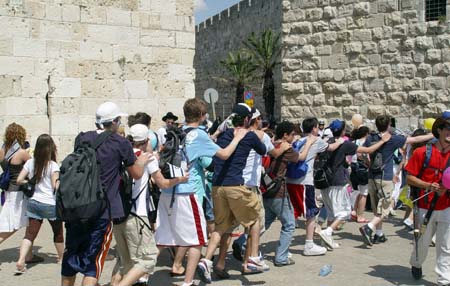
Today is the 58th anniversary of the proclamation of the state of Israel. The day is fixed to the lunar festival of Passover, and the actual date varies from year to year. The proclamation itself took place on May 14, 1948, but this year the anniversary falls today, May 3rd. The celebration was long and furious at the various public venues beginning at sunset yesterday. The music from the concerts punctuated with loud blasts of fireworks echoed through the old city last night (and again tonight) and the distant tam-tam of drums was still going strong when I crossed the courtyard for Matins this morning.
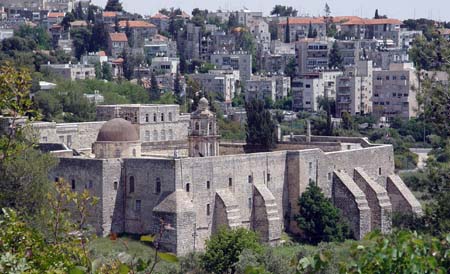
About mid-morning, I set out to explore the area of New Jerusalem near the Israel Museum, across from the country's famous legislature building, the Knesset. Suspecting the museum will be closed for the Independence Day holiday, I pack a picnic lunch and plan to enjoy the Botanical Gardens instead. On reaching the ravine that leads up to the museum and to the gardens, about a 30 minute walk from Jaffa Gate, the sight of the ancient Monastery of the Holy Cross grabs my attention.
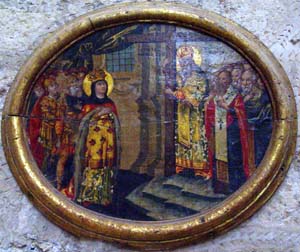 The monastery was founded in the
fourth century by Queen St.
Helena, mother of Constantine the Great, 4th century Emperor of Roman Byzantium.
The monastery was founded in the
fourth century by Queen St.
Helena, mother of Constantine the Great, 4th century Emperor of Roman Byzantium.
Tradition holds that St. Helena ordered the removal of the Temple of Aphrodite erected on the rock of Golgotha and the clearing away of the rubble from the earlier destruction of the city by the Romans, 70 A.D. In fact, it seems that Patriarch Makarios requested permission from Emperor Constantine to undertake this work, believing that it would lead eventually to the discovery the long lost tomb of Jesus. Karen Armstrong reports ...
As the excavations proceeded, Makarios and his colleagues must have had some bad moments: they knew that they had to find something. Yet it was two years before the grand discovery was made. A rock tomb was unearthed beneath the old Temple platform and was immediately declared to be the sepulchre of Christ.
Today, it is this sepulchre -- or what remains after its destruction in 1009 under the rule of the "mad calif" al-Hākim -- that is now the centrepiece of the great basilica Church of the Resurrection in Old Jerusalem, and the focus for the Holy Fire ceremony.
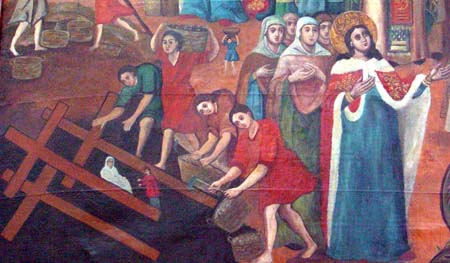
Detail from a painting in the Armenian Patriarchate,
Jerusalem.
Also discovered nearby, legend has it, three wooden crosses, immediately identified as the crosses on which Jesus and the two robbers had been crucified. A miraculous healing of a woman deemed incurably ill (portrayed in white in the painting, above) served to determine which of the three was the true and Holy Cross of Jesus.
According to another tradition, the cross was hewn from a supernatural tree that grew at the site now occupied by the Monastery of the Holy Cross. Adam and Eve's third son Seth planted this tree near the head of his father's grave, which the legend locates here.
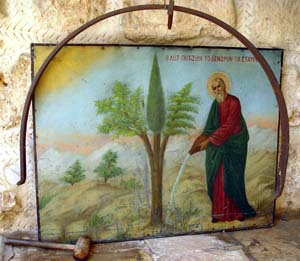 For
the planting, St. Michael the Archangel gave Seth a branch cut from the
famous tree of the knowledge of good and evil, source of the forbidden
fruit; and Seth is portrayed in this icon watering the triple headed sapling
that grew from the planted branch.
(The icon in the picture is framed by the round iron rail and a wooden mallet
used to call the monks of the monastery to prayer.)
For
the planting, St. Michael the Archangel gave Seth a branch cut from the
famous tree of the knowledge of good and evil, source of the forbidden
fruit; and Seth is portrayed in this icon watering the triple headed sapling
that grew from the planted branch.
(The icon in the picture is framed by the round iron rail and a wooden mallet
used to call the monks of the monastery to prayer.)
St. Helena's monastery was destroyed by the Persians in 614 A.D. and rebuilt five centuries later by monks from Mt. Athos, thanks to the financial support of King Bagrat of Georgia. It has remained for the most part intact ever since -- though its isolation from the old city made it vulnerable and to frequent raids and attacks -- thus its fortress design (see the photo above.)
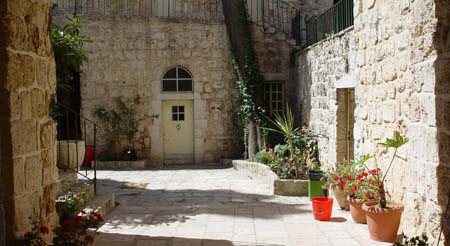
Two small courtyards grace the space within the sturdy walls of the monastery. One serves today as an outdoor café and reception area for pilgrims and visitors who then pass through the second courtyard, only a few feet apart from the first, on their way to the monastery's church.

The walls of the church were painted with icons beginning in the 13th century, and the frescos are quite wonderful and in reasonably good shape following the last major restoration in 1959 and the ongoing efforts to preserve this remarkable heritage.
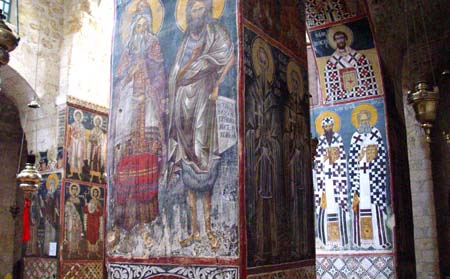
Leaving the monastery, after a brief conversation with the monk who looks after the gift shop there, I walk along the pathways of the ravine and find a quiet corner in a grove of trees -- perhaps the wood of the cross was harvested in a grove much like this -- overlooking the monastery. I pause for lunch and some time with Karen Armstrong's masterful book on the history of the city, Jerusalem: One City, Three Faiths (Ballantine Books, 1997).
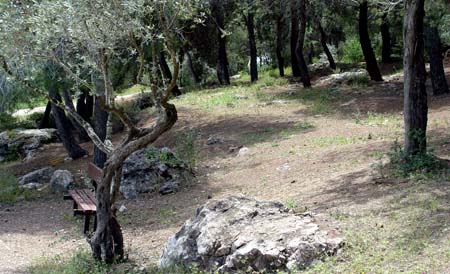
The weather is glorious today, and has been for some time now. The temperature is in the mid-20s (70s Fahrenheit) and the sky is clear and bright blue. After my lunch break, I head up the side of the ravine towards the Israel Museum and am delighted to discover that it is in fact open for the Independence Day holiday. The museum is crowded with Israelis enjoying both the day off and free admission to the museum in honour of the holiday.
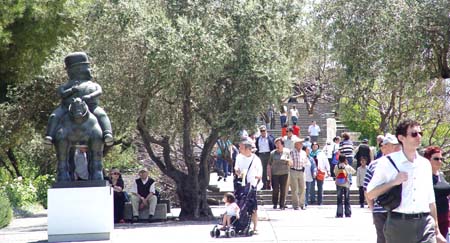
The museum spreads out over a large property, with much of the museum underneath the public walkway pictured above. The walkway opens onto a variety of yards and terraces, like this rose garden with its rock pyramid centrepiece.
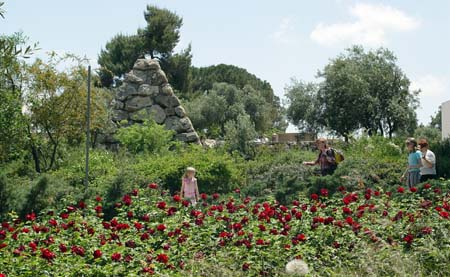
There is a wonderful collection here with quite a few familiar canvases by many of the European giants, including Chagall, Picasso, and Monet. Themes close to the Israeli heart dominate the art collection, and Poussin's large depiction of the Roman destruction of the temple in 70 A.D. is particularly powerful.

The museum's extensive archaeological collection includes a fascinating group of standing "anthropomorphic sarcophagi" -- predating the Egyptian mummy, these clay burial jars are life size or taller and are decorated with wonderful, at times amusing moulded clay faces. Outside, work is underway on the construction of a large scale model of Herodian Jerusalem -- no holiday today for the Palestinian construction workers.
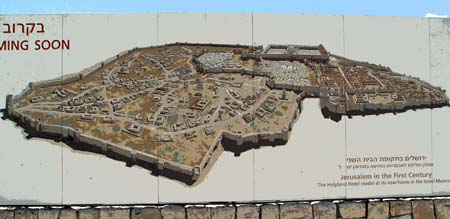
Perhaps he most valuable, certainly the most famous treasure at the Israel Museum, is its collection of the 80 manuscripts from the first and second centuries before Jesus, known to the world as the Dead Sea Scrolls. These, along with other important manuscripts in the museum's collection, are stored in the a separate building on the museum's grounds called the Sanctuary of the Book, with its distinctive roof, pictured here.
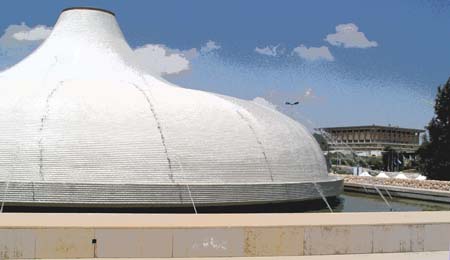
The Knesset building in the background (to the right in the photo, above) forges a visible link with the Temple of the Book bridging the great Jewish scriptural tradition centred on the study of the Law and the business of lawmaking in Israel today. In a slight variation of a comparable Christian adage, Jews believe that God is present when two or three gather for the study of Torah, the Mosaïc Law.
Detecting that I am a bit unsure about the best route to take back to the old city, an Armenian teenager offers some help. She is headed in the same direction and we enjoy a pleasant conversation on the way back to Old Jerusalem.
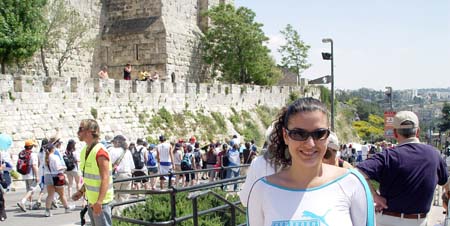
Maggie will be ready to start college in the fall, but is worried that her Hebrew isn't strong enough for work at Jerusalem's Hebrew University. Relatives in the U.S. have suggested she take classes at the community college near their home in Chicago; but Maggie is as yet unsure of the path forward.
Born and raised in the Armenian Quarter, Maggie is only eligible for an identity card from Israel. She is not an Israeli citizen and has had to turn to Jordan for a passport. Independence day for Maggie is no more than a day off from her work at the YMCA; and for the residents of the Armenian Quarter, it is just another normal day, with the Armenian school, seminary, local Armenian shops and businesses, including the offices of the Patriarchate, all open as usual today.
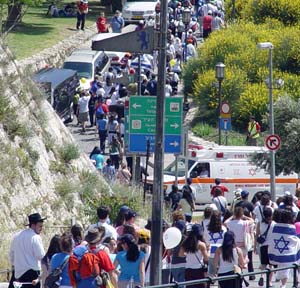 Not so for
the hundreds of Israeli teens marching by Jaffa Gate in a
jubilant procession around the walls of the old
city -- pictured here and at the top of this post.
Not so for
the hundreds of Israeli teens marching by Jaffa Gate in a
jubilant procession around the walls of the old
city -- pictured here and at the top of this post.
Local parks are full of Israeli picnickers, and a festive spirit reigns in the Jewish neighbourhoods of West Jerusalem through which we have been walking on our return to the old city.